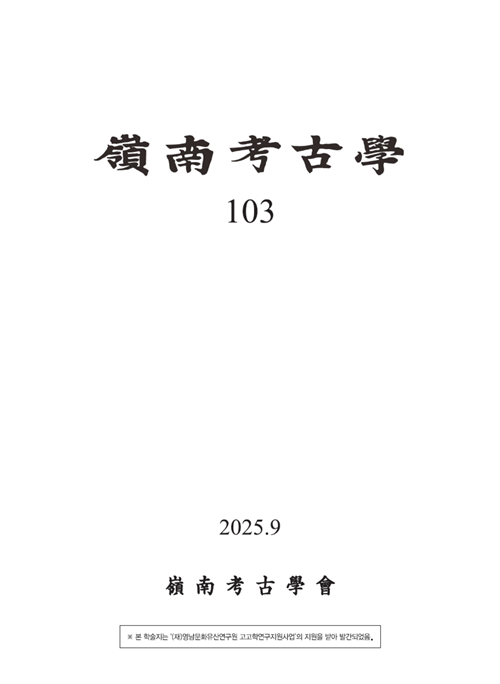- 영문명
- The Characteristics and Significance of Armor from the Geumgwanchong Tomb
- 발행기관
- 영남고고학회
- 저자명
- 김혁중(Hyukjoong Kim)
- 간행물 정보
- 『영남고고학』제103호, 211~227쪽, 전체 17쪽
- 주제분류
- 인문학 > 역사학
- 파일형태
- 발행일자
- 2025.09.30
4,840원
구매일시로부터 72시간 이내에 다운로드 가능합니다.
이 학술논문 정보는 (주)교보문고와 각 발행기관 사이에 저작물 이용 계약이 체결된 것으로, 교보문고를 통해 제공되고 있습니다.

국문 초록
금관총은 한반도 최초로 금관이 확인된 고분으로 널리 알려져 있으며 갑주 연구에 있어서도 금공갑주가출토되어 중요한 의미를 지닌다. 일제강점기 조사 보고서에서는 유물 전체에 대한 보고가 이루어지지 않았으나 2016년 국립경주박물관이 정식 보고서를 발간하면서 금동제 소찰 등 갑주 전체가 밝혀지게 되었다.
금관총 출토 갑주는 투구, 갑옷, 장식갑편, 부속갑으로 구분된다. 투구로는 금동제 복발 1점이 있으며 장찰로 추정되는 만곡한 소찰 일부가 주체부일 가능성이 있다. 찰갑의 소찰은 4가지로 분류되며, 소찰 간 연결은 횡결기법과 수결공을 통해 이루어진 것으로 추정된다. 부속갑으로는 팔뚝가리개인 비갑이 4쌍 이상이며, 일부에 영락 장식과 축조기법이 적용되었다. 경갑은 세장한 금동판 28점으로 구성된다. 경갑에는 반원형 금구가 있어 착장 시 개폐가 가능하며, 착장자의 신체에 맞춰 추가로 투공을 뚫은 흔적이 있다.
신라 고분 중 금관총은 금공갑주가 가장 다양하게 부장된 고분이다. 특히 금관총 출토 금동제 찰갑은 지금까지 한반도에서 확인된 유일한 사례이다. 신라와 가야의 금공갑주를 비교하면, 신라는 주로 비갑만 단독으로 부장하는 경향이 많이 보이는 반면, 가야는 투구를 제작하여 다른 재질의 갑주와 함께 부장하는 특징을보인다. 이는 신라가 금공갑주를 복식제도의 일환으로 제작했을 가능성을 시사한다. 한편, 금관총 비갑에서는 공반된 마구와는 달리 점열문을 사선방향으로 새긴 축조기법이 확인된다. 이는 금공갑주와 장신구·마구의 제작자가 서로 다른 집단이었을 가능성을 보여준다.
한일관계의 측면에서 살펴보면, 왜(倭)의 5세기대 고분에서 출토된 비갑 등 금공갑주 일부는 신라의 제작 기술을 받아들여 현지인 또는 이주인이 제작했을 가능성이 있다. 금관총에서는 패제운주, 패제용기, 곡옥 등 왜와 관련된 물품들이 확인되는데 이는 당시 신라와 왜 사이의 활발한 교류의 증거이다.
영문 초록
The Geumgwanchong Tomb is a representative ancient tomb of Silla from which various burial goods were excavated. While it is widely known for its gold crown, it holds significant importance as various gilt-bronze artifacts, including gilt-bronze armor, were also discovered together. The reports published during the Japanese colonial period lacked detailed analysis of the gilt-bronze armor and contained errors such as misidentifying the bokbal (helmet bowl) as a gilt-bronze vessel. However, with the publication of an official report by the Gyeongju National Museum in 2016, the complete picture of the entire armor set, including previously unknown gilt-bronze lamellar scales, was revealed.
The armor excavated from Geumgwanchong Tomb is functionally classified into helmets, body armor, decorative armor plates, and auxiliary armor. One gilt-bronze bokbal was discovered as a helmet component, and while the main body and cheek guards are missing, some curved scales presumed to be jangchal (long scales) may possibly be parts of the main helmet body. The lamellar scales of the scale armor are divided into upper-round lower-square and rectangular forms in plan view, and are classified into four types based on different widths and lengths. The connection method between scales is presumed to have been achieved through horizontal lacing techniques and vertical lacing holes. As auxiliary armor, at least four pairs of arm guards with treasure-bead-shaped plan forms have been identified, with some featuring decorative pendants and construction techniques. Additionally, the neck guard composed of a total of 28 elongated gilt-bronze plates measures 3cm in width and 25cm in length, with semicircular metal fittings that allow opening and closing when worn, and traces of additional perforations made to fit the wearer's body have been observed.
Comparative analysis with Silla gilt-bronze armor reveals that Geumgwanchong is the tomb with the most diverse types of gilt-bronze armor buried, including both lamellar and plate armor. Particularly, the gilt-bronze scale armor from Geumgwanchong represents the only reported case of such armor discovered on the Korean Peninsula to date. Comparing the gilt-bronze armor of Silla and Gaya, Silla tends to produce arm guards and bury them independently, while Gaya characteristically produces helmets and buries them together with other armor pieces. This suggests the possibility that Silla manufactured gilt-bronze armor as part of a dress code system. Analysis of the construction techniques applied to the Geumgwanchong arm guards revealed a unique technique of engraving dotted line patterns in diagonal directions, suggesting that the craftsmen who made gilt-bronze armor and those who made ornaments and horse gear may have been different groups.
From the perspective of Korea-Japan relations, the gilt-bronze armor excavated from 5th-century Japanese tombs such as Daeseon Tomb, Ojomyo Tomb, and Wolgang Tomb is presumed to have been manufactured locally under the influence of Silla technology. Particularly, the arm guard excavated from Shingai Tomb No. 1 was likely manufactured by locals or immigrants who adopted Silla arm guard production techniques. Simultaneously, items related to Wa (ancient Japan) such as shell-made cloud-shaped beads, shell-made vessels, and curved jade were also identified in Geumgwanchong, demonstrating that active mutual exchange, rather than unilateral interaction, occurred between Silla and Wa at the time.
목차
Ⅰ. 머리말
Ⅱ. 금관총 출토 갑주의 종류
Ⅲ. 금공갑주 비교 분석을 통해 본 금관총 출토 갑주의 특징
Ⅳ. 맺음말
해당간행물 수록 논문
참고문헌
교보eBook 첫 방문을 환영 합니다!

신규가입 혜택 지급이 완료 되었습니다.
바로 사용 가능한 교보e캐시 1,000원 (유효기간 7일)
지금 바로 교보eBook의 다양한 콘텐츠를 이용해 보세요!



